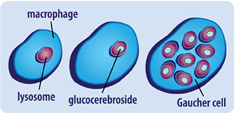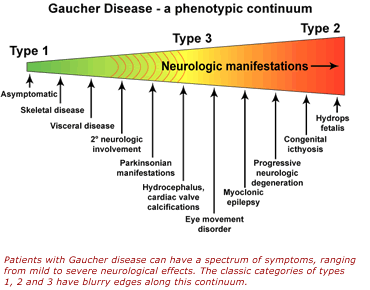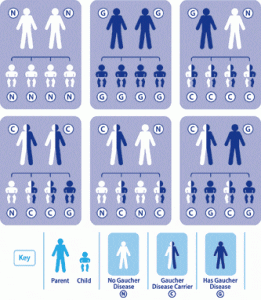Gaucher Basics
What do you do when a doctor diagnoses your child with a rare, lethal disease that no one’s doing new research on? We created a research fund to find a cure.
Gaucher (pronounced “go-shay”) Disease is a genetic disorder, which results in the deficiency in an enzyme, causing a portion of old cells to be stored in areas such as the liver, spleen, lungs, lymph system, and bones instead of being expelled from the body. In more severe cases, which affect young children, they also accumulate in the central nervous system.
What Are Gaucher Cells
 The human body contains specialized cells called macrophages that remove worn-out cells by degrading them into simple molecules for recycling. This process is analogous to eating and digesting food. The macrophages “eat” worn-out cells and degrade them inside cell compartments called lysosomes that serve as the “digestive tracts” of cells. The enzyme glucocerebrosidase (pronounced “gloo-ko-ser-e-bro-si-dase”) is located within the lysosomes and is responsible for breaking down glucocerebroside into glucose and a fat called ceramide.
The human body contains specialized cells called macrophages that remove worn-out cells by degrading them into simple molecules for recycling. This process is analogous to eating and digesting food. The macrophages “eat” worn-out cells and degrade them inside cell compartments called lysosomes that serve as the “digestive tracts” of cells. The enzyme glucocerebrosidase (pronounced “gloo-ko-ser-e-bro-si-dase”) is located within the lysosomes and is responsible for breaking down glucocerebroside into glucose and a fat called ceramide.
People with Gaucher Disease lack the normal form of the glucocerebrosidase enzyme and are unable to break down glucocerebriside. Instead, the glucocerebroside remains stored within the lysosomes preventing the macrophages from functioning normally. Enlarged macrophages containing undigested glucocerebroside are called Gaucher cells. This is why Gaucher Disease is often referred to as a “storage disease”. Because the enzyme is not working properly, these undigested cells are “stored,” and accumulate in various parts of the body.
What Happens When Gaucher Cells Accumulate
Gaucher cells most often accumulate in the spleen, liver, and bone marrow. They may also collect in other tissues, including the lymphatic system, lungs, skin, eyes, kidney, and heart. Frequently, an organ that contains Gaucher cells becomes enlarged and does not function properly, resulting in clinical symptoms associated with the disease. Providing there is no central nervous system (brain) involvement, Gaucher Disease is referred to as Gaucher Type 1. Individuals of all ages can be affected by Gaucher Disease Type 1.
Why Is Gaucher Disease Type 2 and Type 3 More Serious
 In Type 2 and Type 3 Gaucher Disease symptoms generally appear in infancy, or early childhood. Unlike Type 1, the central nervous system (brain) is affected. This can manifest itself with abnormally slow eye movements, unsteadiness, swallowing problems, seizures, among other symptoms. Neurological involvement will range from minimal to severe involvement. Central nervous system involvement is significantly more debilitating, and in many cases, causes death.
In Type 2 and Type 3 Gaucher Disease symptoms generally appear in infancy, or early childhood. Unlike Type 1, the central nervous system (brain) is affected. This can manifest itself with abnormally slow eye movements, unsteadiness, swallowing problems, seizures, among other symptoms. Neurological involvement will range from minimal to severe involvement. Central nervous system involvement is significantly more debilitating, and in many cases, causes death.
What Can Be Done
Gaucher patients can receive enzyme replacement infusions. Enzyme replacement has worked well to control the systemic (non-central nervous system) complications most commonly found in Type 1 patients. However, the replacement enzyme has difficulty crossing the “blood brain” barrier, therefore, in the Type 2 and Type 3 form of Gaucher Disease, it has had no discernible therapeutic effect on the central nervous system, or brain involvement.
Gaucher Disease Is Inherited
Much of a person’s makeup is a result of what is inherited from each parent. Certain characteristics, such as eye color, height, and genetic disease are passed from parents to children. The genes for these characteristics are organized on 23 pairs of chromosomes. Genes contain the blueprints that the body’s cells use to produce proteins, the building blocks of life. Each chromosome contains thousands of genes. An individual normally inherits one copy of each gene from each parent. The genes for glucocerebrosidase are also passed on from parents to children. In Gaucher Disease, the blueprint for the glucocerebrosidase enzyme (a type of protein), is defective. As a result, the glucocerebrosidase produced from the defective genes is unable to perform its normal function.
Is the risk of inheriting Gaucher Disease the same for males and females?
Copies of the gene for glucocerebrosidase are carried on a chromosome that is not involved in determining an individual’s sex. As a result, the defective glucocerebrosidase gene can be passed on to either males or females. One pair of chromosomes, called the sex chromosomes, differs between men and women in a way that determines their sexual identities. The other 22 pairs of chromosomes are called autosomes. The gene for the glucocerebrosidase enzyme is on one of the autosomal chromosome pairs. Gaucher Disease is referred to as an autosomal recessive disorder. Recessive refers to the fact that in order to develop the disease, an individual must inherit two defective copies of the gene, one from each parent.
Who are Gaucher carriers?
A person with one normal gene and one defective gene for glucocerebrosidase is a carrier of Gaucher Disease. Such individuals will not develop Gaucher Disease because as long as one of the two genes for glucocerebrosidase is normal, enough glucocerebrosidase can be produced to prevent glucocerebroside from accumulating. Although a Gaucher carrier will have no symptoms of Gaucher Disease, the odds are 50% that the “Gaucher gene” will be passed on to each of his or her children. A child will only develop Gaucher Disease if he or she inherits a defective gene from both parents.
What are the odds of having children that have Gaucher Disease or who are Gaucher carriers?
 If both parents have normal genes for glucocerebrosidase, each child will inherit two normal genes, one from each parent, and will neither have Gaucher Disease nor be a carrier.
If both parents have normal genes for glucocerebrosidase, each child will inherit two normal genes, one from each parent, and will neither have Gaucher Disease nor be a carrier.- If one parent is a carrier of Gaucher Disease and the other parent is not, there is a 50% chance of having a child who inherits the “Gaucher gene” from the carrier parent, and becomes a carrier of Gaucher Disease. None of the children will have Gaucher Disease, because they will have one normal gene inherited from the other parent.
- If both parents are carriers of Gaucher Disease, with each pregnancy there is a 25% chance of having a child who inherits one “Gaucher gene” from each parent, and thus has Gaucher Disease. There is a 50% chance of having a child who inherits a “Gaucher gene” from one parent and a normal gene from the other parent, and becomes a carrier of Gaucher Disease. Finally, there is a 25% chance for each pregnancy of having a child who inherits two normal genes, one from each parent, and who neither has Gaucher Disease, nor is a carrier.
- It must be emphasized that the odds for each pregnancy, of inheriting Gaucher Disease, are totally independent of whether or not a previous child has Gaucher Disease. Having one child with Gaucher Disease does not mean that the next three children cannot inherit Gaucher Disease.
- If one parent has Gaucher Disease and the other parent does not have Gaucher Disease, nor is a carrier, all children will inherit the “Gaucher gene” from the parent with Gaucher Disease, and will become carriers. None of these children will have Gaucher Disease themselves.
- If one parent has Gaucher Disease and the other parent is a Gaucher carrier, there is a 50% chance of having a child who inherits a “Gaucher gene” from each parent, and thus has Gaucher Disease. There is also a 50% chance of having a child who only inherits the “Gaucher gene” from one parent, and becomes a carrier.
- If both parents have Gaucher Disease, all of their children will inherit two “Gaucher genes” and will have Gaucher Disease as well.






